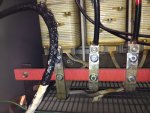wirebender
Senior Member
- Location
- North Central Texas
We were called out to an auto dealer's shop this afternoon that had lost power to a large portion of their equipment.
The problem turned out to be a fuse on one of the utility pole mounted transformers (208Y/120V service) had dropped out, a dead buzzard was found nearby. POCO came out and remedied the situation.
They called us back and the air compressor had tripped the breaker and when they closed it, it went boom.
Air compressor is 480V. There is a transformer mounted above it fed with 125A 208Y/120V.

I opened the transformer and the neutral was melted.

Took all the feed wires loose and had direct shorts between A, B and N. C was clear.
Took the FMC off and the wires were all melted together. 50' away the feeder conduit goes through a wall into an LB. I pulled the wire out some and cut it which cleared the shorts back to the panel. Megged them and they are okay. So we replace the LB with a j-box and refeed the transformer and everything works fine.
Any ideas on the cause of this?
Could the single phasing from the POCO had done this?
Why was the neutral melted?
The transformer is bonded with an EGC.
There is no GEC. Does it not need one without a derived neutral? I'm a little unsure about proper procedure when you are hooking up a transformer backward.
None of the derived phases are grounded and no fault detection equipment is used.
Should we ground one of these phases and wouldn't that require a GEC?

While we were there they started noticing other things not working properly. Some F bays, some equip in the car wash, etc.
Could the single phasing from the POCO have caused unseen damage. What should I look for and what tests should be run to check out the system?
Sorry, lots of questions, just don't want to leave an unsafe situation.
The problem turned out to be a fuse on one of the utility pole mounted transformers (208Y/120V service) had dropped out, a dead buzzard was found nearby. POCO came out and remedied the situation.
They called us back and the air compressor had tripped the breaker and when they closed it, it went boom.
Air compressor is 480V. There is a transformer mounted above it fed with 125A 208Y/120V.

I opened the transformer and the neutral was melted.

Took all the feed wires loose and had direct shorts between A, B and N. C was clear.
Took the FMC off and the wires were all melted together. 50' away the feeder conduit goes through a wall into an LB. I pulled the wire out some and cut it which cleared the shorts back to the panel. Megged them and they are okay. So we replace the LB with a j-box and refeed the transformer and everything works fine.
Any ideas on the cause of this?
Could the single phasing from the POCO had done this?
Why was the neutral melted?
The transformer is bonded with an EGC.
There is no GEC. Does it not need one without a derived neutral? I'm a little unsure about proper procedure when you are hooking up a transformer backward.
None of the derived phases are grounded and no fault detection equipment is used.
Should we ground one of these phases and wouldn't that require a GEC?

While we were there they started noticing other things not working properly. Some F bays, some equip in the car wash, etc.
Could the single phasing from the POCO have caused unseen damage. What should I look for and what tests should be run to check out the system?
Sorry, lots of questions, just don't want to leave an unsafe situation.

